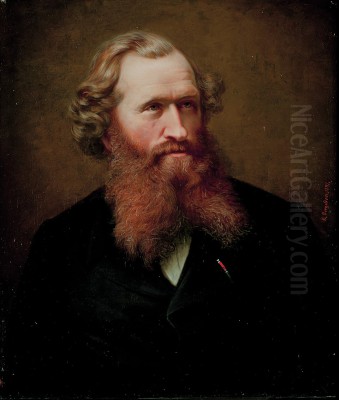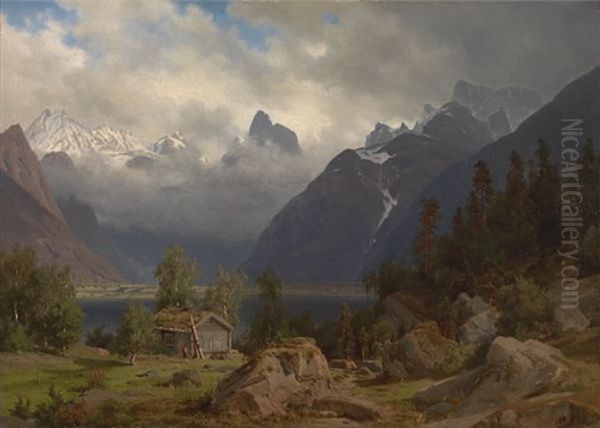
Johan Fredrik Eckersberg stands as a pivotal figure in the annals of Norwegian art, particularly celebrated for his evocative landscape paintings that captured the majestic and often untamed spirit of his homeland. Born in Drammen, Norway, on June 16, 1822, and passing away in Sandvika, Bærum, on July 13, 1870, Eckersberg's relatively short life was immensely productive. He not only created a significant body of work that defined a generation of Norwegian Romanticism but also played a crucial role as an educator, nurturing a new wave of artistic talent. His dedication to depicting the unique character of Norwegian nature, combined with his pedagogical efforts, cemented his legacy as one of Norway's most influential 19th-century artists.
Early Life and Artistic Inclinations
Johan Fredrik Eckersberg's journey into the world of art began in Drammen, a bustling timber port, which perhaps offered early glimpses of dramatic natural scenery and the interplay of light and shadow. His father was a merchant, and it was not immediately apparent that young Johan Fredrik would pursue an artistic career. However, an innate sensitivity to his surroundings and a burgeoning talent for drawing soon became evident.
His formal artistic training commenced under the tutelage of Johannes Flintoe, a Danish-Norwegian painter known for his landscapes and folk-life scenes. Flintoe, who taught at the Royal School of Drawing in Christiania (now Oslo), was an important early influence, likely instilling in Eckersberg a foundational appreciation for the direct observation of nature and the burgeoning ideals of National Romanticism, which sought to define and celebrate a distinct Norwegian cultural identity through art and literature. This early exposure to a master who valued the Norwegian landscape was crucial in shaping Eckersberg's future artistic direction.
The Düsseldorf Influence: Forging a Romantic Vision

To further hone his skills, Eckersberg, like many aspiring Scandinavian artists of his generation, traveled to Germany. He enrolled at the prestigious Kunstakademie Düsseldorf between 1846 and 1848. The Düsseldorf Academy was a leading center for art education in Europe at the time, particularly renowned for its school of landscape painting. Here, he studied under Johann Wilhelm Schirmer, a prominent landscape painter and a key proponent of the Düsseldorf School's detailed, often idealized, yet naturalistic approach to landscape.
The Düsseldorf School emphasized meticulous attention to detail, a smooth finish, and often imbued landscapes with a romantic or heroic atmosphere. Artists were encouraged to make outdoor sketches but would typically compose their larger canvases in the studio, sometimes combining elements from different studies to create a more perfect or dramatic scene. This training profoundly impacted Eckersberg, refining his technique and deepening his understanding of composition and the dramatic potential of landscape. During his time in Düsseldorf, he would have been in the company of other notable Norwegian artists, such as Hans Gude and Adolph Tidemand, who were also central figures in Norwegian Romanticism and helped to establish the "Düsseldorf School" style within Norwegian art.
Return to Norway: Capturing the National Spirit
Upon his return to Norway, Eckersberg dedicated himself to capturing the grandeur and unique character of the Norwegian landscape. This was an era of fervent national awakening in Norway, which had gained autonomy from Denmark in 1814 (though still in union with Sweden). Artists played a vital role in forging a national identity, and the depiction of Norway's distinctive natural environment became a powerful means of expressing this burgeoning national pride.
Eckersberg's paintings from this period are characterized by their majestic mountain scenes, deep fjords, cascading waterfalls, and serene forest interiors. He often chose to depict the high mountain regions, such as Jotunheimen and Romsdalen, areas that were increasingly being explored and celebrated for their sublime beauty. His works were not mere topographical records; they were imbued with a romantic sensibility, seeking to convey the emotional impact of these landscapes – their vastness, their solitude, and their often-dramatic weather conditions. He masterfully used light and shadow to create mood and depth, highlighting the rugged textures of rock formations and the delicate tracery of trees.
Masterpieces and Signature Style
Johan Fredrik Eckersberg's artistic style is firmly rooted in the Romantic tradition, yet it also displays a keen observational skill that lends a sense of realism to his dramatic portrayals. He was particularly adept at rendering the atmospheric effects of the Norwegian climate, from the clear, crisp light of a summer day in the mountains to the misty veils that often shroud the fjords.
One of his most celebrated works is "Fra Romsdalen" (From Romsdalen), often translated as "Grand View of Romsdalen" (1865). This painting exemplifies his mature style, showcasing a panoramic vista of the dramatic Romsdalen valley with its towering peaks, such as Romsdalshorn. The composition is carefully structured, leading the viewer's eye deep into the landscape, while the meticulous rendering of geological formations and foliage demonstrates his Düsseldorf training. Yet, the overall effect is one of awe-inspiring natural grandeur, a hallmark of Romantic landscape painting.
Another significant piece, "Solnedgang på fjellet" (Sunset in the Mountains), captures the ethereal beauty of the alpine glow, a phenomenon where mountain peaks are illuminated by the setting sun. Such works highlight his sensitivity to color and light, and his ability to evoke a profound emotional response to the natural world. His paintings often feature a strong sense of verticality, emphasizing the soaring heights of the mountains, and a careful balance between detailed foreground elements and more atmospheric, distant views. While he often included small human figures in his landscapes, they typically served to emphasize the scale and majesty of nature, rather than being the primary focus.
The Eckersberg Art School: A Legacy of Teaching
Beyond his own artistic production, Johan Fredrik Eckersberg made a lasting contribution to Norwegian art through his role as an educator. In 1859, he founded a private art school in Christiania, known as "Eckersbergs malerskole" (Eckersberg's Painting School). At a time when opportunities for formal art education within Norway were limited, his school provided a crucial training ground for a new generation of artists.
Eckersberg's teaching methods were likely influenced by his own academic training, emphasizing strong foundational skills in drawing and a deep understanding of composition and perspective. He encouraged his students to study nature directly, a principle that was becoming increasingly important. His school quickly gained a reputation for excellence and attracted many talented young individuals who would go on to become significant figures in Norwegian art.
Among his notable students were Harriet Backer, one of Norway's foremost female painters, known for her sensitive interior scenes and mastery of light. Christian Krogh, a leading figure in the transition from Romanticism to Realism and Naturalism in Norway, also spent some time at Eckersberg's school before pursuing further studies abroad. Eilif Peterssen, celebrated for his historical paintings and portraits, and Kitty Lange Kielland, a prominent landscape painter and an early advocate for women artists, also benefited from his instruction. Other students included the landscape and marine painter Hans Dahl, and Morten Müller, who became known for his idyllic forest and coastal scenes. The school thus played a vital role in shaping the future direction of Norwegian art, bridging the gap between the established Romantic tradition and the emerging trends of Realism.
Contemporaries and the Norwegian Art Scene
Johan Fredrik Eckersberg operated within a vibrant and evolving Norwegian art scene. His work should be seen in the context of other leading figures of Norwegian National Romanticism. Hans Gude, a close contemporary and fellow Düsseldorf alumnus, was a dominant force in Norwegian landscape painting, known for his coastal scenes and mountain vistas, often co-creating iconic works like "The Bridal Procession in Hardanger" with Adolph Tidemand. Tidemand himself specialized in folk-life scenes, capturing the traditions and rural culture of Norway, which complemented the landscape painters' focus on the natural environment.
August Cappelen, another artist associated with the Düsseldorf School, was known for his melancholic and wild forest landscapes, often depicting decaying trees and a sense of primeval nature. His early death cut short a promising career. Lars Hertervig, a more enigmatic and highly individualistic artist, created visionary landscapes of the coastal regions around Stavanger, marked by a unique use of light and form that set him apart from his contemporaries.
Peder Balke was an earlier Romantic painter whose dramatic and often stormy depictions of the North Norwegian coast, with their bold brushwork and expressive style, prefigured some later trends. Knud Bergslien, primarily a painter of historical subjects and portraits, also contributed to the National Romantic movement and later became an influential teacher himself. These artists, along with Eckersberg, collectively helped to define a distinctly Norwegian school of painting in the mid-19th century, each contributing their unique perspective to the celebration of Norway's identity. The interactions, shared influences (like the Düsseldorf School), and distinct individual paths of these artists created a rich tapestry of artistic development during this formative period.
Later Years, Untimely Death, and Lasting Legacy
Johan Fredrik Eckersberg continued to paint and teach throughout the 1860s, remaining a respected figure in the Norwegian art world. His dedication to his art school was particularly significant, as it provided a much-needed local institution for aspiring painters. However, his career was tragically cut short. He suffered from tuberculosis, and his health gradually declined. He passed away in 1870 at the age of only 48.
Despite his relatively brief life, Eckersberg's impact on Norwegian art was profound and multifaceted. As a painter, he produced a body of work that stands among the finest examples of Norwegian Romantic landscape painting. His depictions of the Norwegian wilderness, particularly its mountainous regions, helped to shape the national imagination and contributed to the growing appreciation for the country's natural heritage. His ability to combine detailed realism with a powerful sense of romantic grandeur set a high standard for landscape art in Norway.
As an educator, his influence extended to a generation of artists who would go on to lead Norwegian art into new directions in the latter part of the 19th century. By providing quality instruction within Norway, he helped to reduce the necessity for young artists to travel abroad for their entire education, fostering a more indigenous artistic development. His students, like Harriet Backer and Christian Krogh, carried forward a commitment to quality and observation, even as they explored new artistic styles such as Realism and Impressionism.
Conclusion: An Enduring Figure in Norwegian Art
Johan Fredrik Eckersberg remains an enduring figure in the history of Norwegian art. His legacy is preserved not only in his magnificent landscape paintings, which continue to be admired for their technical skill and emotional depth, but also in the subsequent achievements of the artists he mentored. He was a key participant in the National Romantic movement, using his art to explore and celebrate the unique identity of Norway through its awe-inspiring natural environment. His commitment to both his own artistic vision and the development of future talent ensures his place as a cornerstone of 19th-century Norwegian culture. His art serves as a timeless window into the soul of the Norwegian landscape, captured with the eye of a keen observer and the heart of a true Romantic.